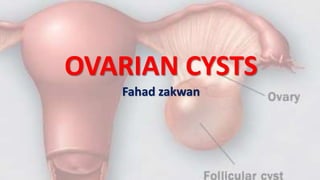
Ovarian cysts
- 2. Introduction • Ovarian enlargements can be cystic or solid but in most cases ovarian enlargement are cystic. Non-neoplastic Neoplastic (Ovarian Tumors)
- 3. Non-neoplastic cysts of the ovary • An ovarian cyst is a sac filled with liquid or semi-liquid material arising in an ovary. • The number of diagnoses of ovarian cysts has increased with the widespread implementation of regular physical examinations and ultrasound technology. • The finding of an ovarian cyst causes considerable anxiety for women because of the fear of malignancy, but the vast majority of ovarian cysts are benign.
- 4. TYPES OF OVARIAN CYSTS. 1. POLYSTIC OVARIAN SYNDROME (PCOS) 2. ENDOMETRIOMATOUS CYSTS 3. FUNCTIONAL CYSTS (commonest) –Follicular cysts –Theca lutein cysts –Corpus luteum cysts.
- 6. FUNCTIONAL CYSTS Ovarian cysts arising in the normal process of ovulation • They may be follicular ,theca-lutein or corpus luteum cysts. • These cysts can be stimulated by gonadotropins, including follicle-stimulating hormone (FSH) and human chorionic gonadotropin (hCG).
- 7. • Multiple functional cysts can occur as a result of excessive gonadotropin stimulation or sensitivity • This stimulation may occurs in cases of GTDs (hydatiform mole and choriocarcinoma) multiple pregnancy. In patients being treated for infertility, ovulation induction with gonadotropins (FSH and luteinizing hormone [LH]), and clomiphene citrate, may lead to ovarian hyperstimulation syndrome, especially if accompanied by hCG administration
- 8. ENDOMETRIOMATOUS CYSTS OF THE OVARY • Cysts filled with blood arising from the ectopic endometrium. • They usually enlarge pre and during menses and slightly shrink there after. The ovary is the commonest site of pelvic endometriosis.
- 9. POLYCYSTIC OVARIAN SYNDROME (PCOS)
- 11. Risk factors of ovarian cysts 1. Hypothyroidism 2. Infertility or women who are on treatment for infertility 3. Those taking tamoxifen, a drug to combat breast cancer 4. Irregular periods 5. Early periods (before 11 years) 6. Previous history of ovarian cysts. 7. A drug called clomiphene may lead to formation of corpus luteum cyst.
- 12. Rotterdam criteria for diagnosis of PCOS 1. Menstrual irregularities. Most patients with PCOS have menstrual irregularities that begin during adolescence. –Oligomenorrhea: less than nine menses per year –Amenorrhea: no menses for 6 months or three or more skipped cycles Difficulty in conceiving is present in many women with PCOS
- 13. 2. Hyperandrogenism. Patients may either show signs of clinical hyperandrogenism or have biochemical hyperandrogenism: –Clinical hyperandrogenism: e.g hirsutism, acne, or male pattern hair loss. –Biochemical hyperandrogenism: Up to 90% of women with PCOS have elevated serum androgen concentration. However, the androgen levels may be normal.
- 14. 3. Polycystic ovaries. A diagnosis of polycystic- appearing ovaries can be made using pelvic ultrasound. –PCOS by ultrasound criteria is defined as 12 or more antral follicles between 2 and 9 mm in size and peripheral in location in at least one ovary –Transvaginal ultrasound is more sensitive, but may not be appropriate to perform in a young female.
- 15. History: Clinical presentation of ovarian cysts • The majority of ovarian cysts are asymptomatic. • Pain or discomfort may occur in the lower abdomen. Torsion (twisting) or rupture may lead to more severe pain. • Patients may experience discomfort with intercourse, particularly deep penetration. • Having bowel movements may be difficult, or pressure may develop, leading to a desire to defecate.
- 16. • Micturition may occur frequently and is due to pressure on the bladder. • Patients may experience abdominal fullness and bloating. • Endometriomas are associated with endometriosis, which causes a classic triad of painful and heavy periods and dyspareunia. • Patients with polycystic ovary syndrome presents hirsutism, infertility, oligomenorrhea, obesity, and acne. Note that infertility is not a rule.
- 17. Physical findings • A large cyst may be palpable during the abdominal examination • Sometimes, discerning the cystic nature of an ovarian cyst may be possible, and it may be tender to palpation. • If a cyst is huge ,The cervix and uterus may be pushed to one side.
- 18. Laboratory Studies: • No laboratory tests are diagnostic for ovarian cysts except for PCOS for which hormone assays are done: FSH LH Testosterone Oestradiol
- 19. Imaging Studies: •Ultrasonography •Doppler flow studies •MRI •CT scan
- 20. Medical Care: •Many patients with simple ovarian cysts based on ultrasonography findings do not require treatment.
- 21. Surgical Care: • Persistent simple ovarian cysts larger than 5-10 cm and complex ovarian cysts should be removed surgically. Laparotomy Laparascopically
- 22. The following diagnostic tests may also be ordered: • Ultrasound scan - this will be carried out to help the doctor make a diagnosis. A wand-like scanner probe (transducer) is placed on the abdomen, over where the ovaries are. • Sometimes the probe may be placed inside the vagina. In both cases, the doctor is observing the ovaries on a video screen. This test can help the doctor determine whether there is a cyst, and whether it is solid, filled with fluid (or both).
- 23. • Blood test - if there is a tumor present blood levels of CA125 (a protein) will be elevated. • High CA125 levels could also mean the patient has ovarian cancer. If a woman develops an ovarian cyst that is partially solid she may have ovarian cancer. • High CA125 levels may also be present in other conditions, including endometriosis, uterine fibroids or pelvic inflammatory disease.
- 24. • Laparoscopy - a thin, lighted instrument (laparoscope) is inserted into the patient's abdomen through a small incision (skin cut). If the doctor spots an ovarian cyst he/she may also remove it there and then.
- 25. •Pregnancy test - a positive result may suggest the patient has a corpus luteum cyst
- 26. Complications of ovarian cysts • Torsion • Rupture • Hemorrhage • ?Malignant change :remains unproven
- 27. Prognosis: The prognosis for benign cysts is excellent
